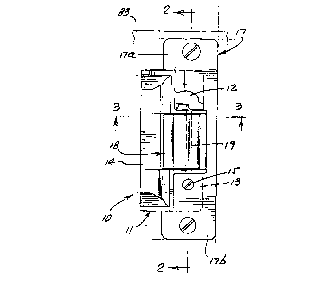Une partie des informations de ce site Web a été fournie par des sources externes. Le gouvernement du Canada n'assume aucune responsabilité concernant la précision, l'actualité ou la fiabilité des informations fournies par les sources externes. Les utilisateurs qui désirent employer cette information devraient consulter directement la source des informations. Le contenu fourni par les sources externes n'est pas assujetti aux exigences sur les langues officielles, la protection des renseignements personnels et l'accessibilité.
L'apparition de différences dans le texte et l'image des Revendications et de l'Abrégé dépend du moment auquel le document est publié. Les textes des Revendications et de l'Abrégé sont affichés :
| (12) Demande de brevet: | (11) CA 2228194 |
|---|---|
| (54) Titre français: | DISPOSITIF DE VERROUILLAGE DE PENE ACTIVE PAR UN INCENDIE |
| (54) Titre anglais: | BOLT CLOSURE MAINTENANCE FOR FIRE-DEGRADED LATCHING ASSEMBLY |
| Statut: | Réputée abandonnée et au-delà du délai pour le rétablissement - en attente de la réponse à l’avis de communication rejetée |
| (51) Classification internationale des brevets (CIB): |
|
|---|---|
| (72) Inventeurs : |
|
| (73) Titulaires : |
|
| (71) Demandeurs : |
|
| (74) Agent: | GOWLING WLG (CANADA) LLP |
| (74) Co-agent: | |
| (45) Délivré: | |
| (22) Date de dépôt: | 1998-01-28 |
| (41) Mise à la disponibilité du public: | 1998-08-18 |
| Requête d'examen: | 2002-04-15 |
| Licence disponible: | S.O. |
| Cédé au domaine public: | S.O. |
| (25) Langue des documents déposés: | Anglais |
| Traité de coopération en matière de brevets (PCT): | Non |
|---|
| (30) Données de priorité de la demande: | ||||||
|---|---|---|---|---|---|---|
|
Verrou de porte comprenant : un pêne; un dispositif de déplacement permettant de faire pivoter le pêne d'une position déverrouillée à une positIon verrouillée; et un dispositif, logé dans une partie du verrou résistante au feu, qui réagit à une augmentation de température, lorsque celle-ci atteint une valeur T, en se déplaçant de manière à bloquer le pêne pour l'empêcher de passer à la position déverrouillée.
In a door closure assembly, the combination
comprising a latch bolt element; carrier structure to
carry the bolt element to pivot between door unlatched
and latched position; and means carried by a fire
resistant portion of the assembly to be responsive to
an increase in temperature to a level T to move into
position to block door unlatching movement of the bolt
element from door latching position.
Note : Les revendications sont présentées dans la langue officielle dans laquelle elles ont été soumises.
Note : Les descriptions sont présentées dans la langue officielle dans laquelle elles ont été soumises.

2024-08-01 : Dans le cadre de la transition vers les Brevets de nouvelle génération (BNG), la base de données sur les brevets canadiens (BDBC) contient désormais un Historique d'événement plus détaillé, qui reproduit le Journal des événements de notre nouvelle solution interne.
Veuillez noter que les événements débutant par « Inactive : » se réfèrent à des événements qui ne sont plus utilisés dans notre nouvelle solution interne.
Pour une meilleure compréhension de l'état de la demande ou brevet qui figure sur cette page, la rubrique Mise en garde , et les descriptions de Brevet , Historique d'événement , Taxes périodiques et Historique des paiements devraient être consultées.
| Description | Date |
|---|---|
| Inactive : CIB de MCD | 2006-03-12 |
| Demande non rétablie avant l'échéance | 2005-01-28 |
| Le délai pour l'annulation est expiré | 2005-01-28 |
| Réputée abandonnée - omission de répondre à un avis sur les taxes pour le maintien en état | 2004-01-28 |
| Lettre envoyée | 2002-05-29 |
| Modification reçue - modification volontaire | 2002-04-15 |
| Requête d'examen reçue | 2002-04-15 |
| Toutes les exigences pour l'examen - jugée conforme | 2002-04-15 |
| Exigences pour une requête d'examen - jugée conforme | 2002-04-15 |
| Demande publiée (accessible au public) | 1998-08-18 |
| Inactive : CIB attribuée | 1998-05-27 |
| Inactive : CIB attribuée | 1998-05-27 |
| Inactive : CIB en 1re position | 1998-05-27 |
| Symbole de classement modifié | 1998-05-27 |
| Modification reçue - modification volontaire | 1998-05-08 |
| Inactive : Certificat de dépôt - Sans RE (Anglais) | 1998-04-22 |
| Demande reçue - nationale ordinaire | 1998-04-22 |
| Date d'abandonnement | Raison | Date de rétablissement |
|---|---|---|
| 2004-01-28 |
Le dernier paiement a été reçu le 2003-01-13
Avis : Si le paiement en totalité n'a pas été reçu au plus tard à la date indiquée, une taxe supplémentaire peut être imposée, soit une des taxes suivantes :
Les taxes sur les brevets sont ajustées au 1er janvier de chaque année. Les montants ci-dessus sont les montants actuels s'ils sont reçus au plus tard le 31 décembre de l'année en cours.
Veuillez vous référer à la page web des
taxes sur les brevets
de l'OPIC pour voir tous les montants actuels des taxes.
| Type de taxes | Anniversaire | Échéance | Date payée |
|---|---|---|---|
| Taxe pour le dépôt - générale | 1998-01-28 | ||
| Enregistrement d'un document | 1998-01-28 | ||
| TM (demande, 2e anniv.) - générale | 02 | 2000-01-28 | 1999-12-07 |
| TM (demande, 3e anniv.) - générale | 03 | 2001-01-29 | 2000-12-20 |
| TM (demande, 4e anniv.) - générale | 04 | 2002-01-28 | 2001-12-17 |
| Requête d'examen - générale | 2002-04-15 | ||
| TM (demande, 5e anniv.) - générale | 05 | 2003-01-28 | 2003-01-13 |
Les titulaires actuels et antérieures au dossier sont affichés en ordre alphabétique.
| Titulaires actuels au dossier |
|---|
| ADAMS RITE MANUFACTURING CO. |
| Titulaires antérieures au dossier |
|---|
| ALAN K. UYEDA |